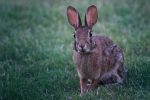Cottontail rabbit! Have you ever heard about it? Well, as you can tell from the name, Cottontail rabbits have stub tails with white underside, just like European rabbit so that is why they closely resemble each other. Technically, the cottontail is one of the Syvilagus species and the closest relative is the pygmy rabbit. Are you interested in the Cottontail rabbits? Then let’s talk about all the things about them!
All Things About Cottontail Rabbit That You Should Know
Where do the Cottontail rabbit live?
Cottontail rabbits are widely spread across northern and central South America, North America, and Central America as well. They live in meadows, fields, or forage that can let them hide easily from their predators.
Generally, cottontail rabbit lives in nests that are known as forms. The nest will be the place for them to rest, sleep, and also raise their young since the young Cottontail rabbits are altricial, which means the young that need to be taken care of for a long time after being born. However, they don’t dig their burrows but instead, they usually use the abandoned burrows from other animals.
How do the Cottontail rabbits look like?
The cottontail rabbit size ranges from 14 to 19 inches in length. The tail itself is 3 inches long! The cottontail rabbits are weighing from 2 to 3 pounds, and just like any other rabbits, the does are usually larger than the bucks. The cottontail rabbit’s color can range from grayish brown to a reddish-brown color. Their bellies are in white or pale gray, with the rusty-hued back of the neck. The colors of the cottontail rabbits can help them to blend in with their surroundings and hide from their predators. The unique thing is, their fur can adapt to the weather and change into the shade of gray and also grow longer.
What do the Cottontail rabbits eat?
Just like any other rabbis, Cottontail rabbits are herbivores that eat plants based on their habitat and the season. Usually, they eat grasses, clover, timothy, alfalfa, hay, and barleys. They also eat several types of fruits like apple or corn, especially in the autumn. On the other hand, during winter, they eat small grains, twigs, buds, and also sprouts. The cottontail rabbits will also eat their feces! Don’t worry, though. They need to consume their faces to get additional nutrition that can help their digest system.
Talking about their food, the Cottontail rabbits have a different way to eat their food. Instead of holding the food with their front paws and sitting on their hind legs like many other rodents, the Cottontail rabbit eats while on all fours and use their nose to adjust their food position. They only use their front paws to eat when the food is above their heads, like on a branch of living plant, so they have to reach it out with their cute paws.
The Cottontail rabbits’ breeding habit
The Cottontail rabbits’ breeding season begins in early February. They are polygynous, where one male can mate with several females. It takes at least 28 days for the baby to be born. The newborns will have no fur and blind at first, but then they will grow rapidly within a week. However, the baby is prone to predators and extreme weathers so many of them usually cannot even survive more than 4 months old.
The Cottontail rabbits’ other habit and personality
The cottontail rabbits are solitary animals. They are territorial as well. They do not hibernate during winter, and also more active during nights because they are nocturnal.
How long do the Cottontail rabbits live?
The cottontail rabbit can live for an average of two years. Their predators are usually the birds of prey and unluckily because their habit to live for a long time in the same burrow, their predators can learn and tell where the cottontail rabbit lives.
How do the Cottontail rabbits survive from predators?
Cottontail rabbits have a lot of predators that can hunt them. However, they are blessed with a sharp sense not only on their eyesight but also their hearing and smell. They depend on their senses to survive by running from their incoming predators. Hence, the Cottontail rabbit may not go out from their burrow during windy days because the wind may interfere with their sense of hearing.
We may think that rabbit will always move by hopping, but usually, when they feel threatened, instead of hopping out from the situation, the Cottontail rabbit probably freeze in place, or even run in a zig-zag pattern! When they are captured, they will thump their hind feet on the ground and scream in high pitch.
Are the Cottontail rabbits good pets?
As we know, the rabbit can be an excellent companion. Rabbits are one of the most popular pets. However, Cottontail rabbits are not one of the types of pet rabbits. They don’t tameable because the Cottontail rabbit is a wild animal. So, sorry! We can’t have them as a pet.
Cottontail rabbits’ role in the environment
The cottontail rabbit may be tiny and not in a high position of the food chain, but they do have an important role in it. They comprise the diets of many predators like foxes, owls, hawks, or other smaller ones. The number and growth of the Cottontail rabbit population are important not only for other animals but also for humans! If the cottontail rabbit overpopulates, their predators will hunt them a lot more instead of hunting down the farm animal.
That is all about the Cottontail rabbit that we should know. After this, we know that Cottontail rabbit lives in an abandoned burrow, they eat different types of plants depending on the season and have an unusual way to eat, and depend a lot with their senses to survive from their predators. They are also a wild rabbit so we cannot have them as a pet.

